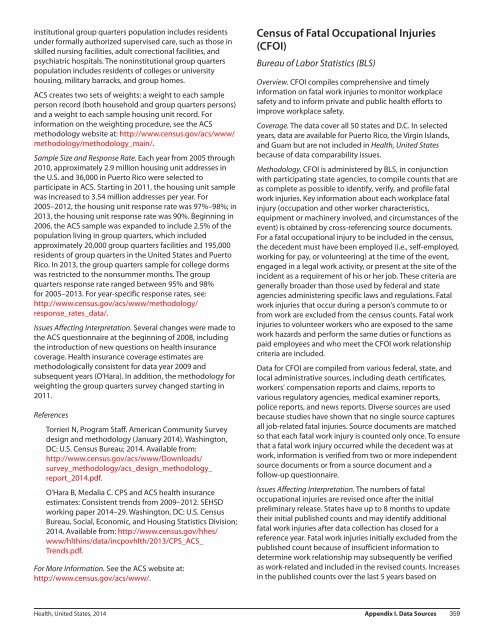hus14
hus14
hus14
You also want an ePaper? Increase the reach of your titles
YUMPU automatically turns print PDFs into web optimized ePapers that Google loves.
institutional group quarters population includes residents<br />
under formally authorized supervised care, such as those in<br />
skilled nursing facilities, adult correctional facilities, and<br />
psychiatric hospitals. The noninstitutional group quarters<br />
population includes residents of colleges or university<br />
housing, military barracks, and group homes.<br />
ACS creates two sets of weights: a weight to each sample<br />
person record (both household and group quarters persons)<br />
and a weight to each sample housing unit record. For<br />
information on the weighting procedure, see the ACS<br />
methodology website at: http://www.census.gov/acs/www/<br />
methodology/methodology_main/.<br />
Sample Size and Response Rate. Each year from 2005 through<br />
2010, approximately 2.9 million housing unit addresses in<br />
the U.S. and 36,000 in Puerto Rico were selected to<br />
participate in ACS. Starting in 2011, the housing unit sample<br />
was increased to 3.54 million addresses per year. For<br />
2005–2012, the housing unit response rate was 97%–98%; in<br />
2013, the housing unit response rate was 90%. Beginning in<br />
2006, the ACS sample was expanded to include 2.5% of the<br />
population living in group quarters, which included<br />
approximately 20,000 group quarters facilities and 195,000<br />
residents of group quarters in the United States and Puerto<br />
Rico. In 2013, the group quarters sample for college dorms<br />
was restricted to the nonsummer months. The group<br />
quarters response rate ranged between 95% and 98%<br />
for 2005–2013. For year-specific response rates, see:<br />
http://www.census.gov/acs/www/methodology/<br />
response_rates_data/.<br />
Issues Affecting Interpretation. Several changes were made to<br />
the ACS questionnaire at the beginning of 2008, including<br />
the introduction of new questions on health insurance<br />
coverage. Health insurance coverage estimates are<br />
methodologically consistent for data year 2009 and<br />
subsequent years (O'Hara). In addition, the methodology for<br />
weighting the group quarters survey changed starting in<br />
2011.<br />
References<br />
Torrieri N, Program Staff. American Community Survey<br />
design and methodology (January 2014). Washington,<br />
DC: U.S. Census Bureau; 2014. Available from:<br />
http://www.census.gov/acs/www/Downloads/<br />
survey_methodology/acs_design_methodology_<br />
report_2014.pdf.<br />
O'Hara B, Medalia C. CPS and ACS health insurance<br />
estimates: Consistent trends from 2009–2012. SEHSD<br />
working paper 2014–29. Washington, DC: U.S. Census<br />
Bureau, Social, Economic, and Housing Statistics Division;<br />
2014. Available from: http://www.census.gov/hhes/<br />
www/hlthins/data/incpovhlth/2013/CPS_ACS_<br />
Trends.pdf.<br />
For More Information. See the ACS website at:<br />
http://www.census.gov/acs/www/.<br />
Census of Fatal Occupational Injuries<br />
(CFOI)<br />
Bureau of Labor Statistics (BLS)<br />
Overview. CFOI compiles comprehensive and timely<br />
information on fatal work injuries to monitor workplace<br />
safety and to inform private and public health efforts to<br />
improve workplace safety.<br />
Coverage. The data cover all 50 states and D.C. In selected<br />
years, data are available for Puerto Rico, the Virgin Islands,<br />
and Guam but are not included in Health, United States<br />
because of data comparability issues.<br />
Methodology. CFOI is administered by BLS, in conjunction<br />
with participating state agencies, to compile counts that are<br />
as complete as possible to identify, verify, and profile fatal<br />
work injuries. Key information about each workplace fatal<br />
injury (occupation and other worker characteristics,<br />
equipment or machinery involved, and circumstances of the<br />
event) is obtained by cross-referencing source documents.<br />
For a fatal occupational injury to be included in the census,<br />
the decedent must have been employed (i.e., self-employed,<br />
working for pay, or volunteering) at the time of the event,<br />
engaged in a legal work activity, or present at the site of the<br />
incident as a requirement of his or her job. These criteria are<br />
generally broader than those used by federal and state<br />
agencies administering specific laws and regulations. Fatal<br />
work injuries that occur during a person's commute to or<br />
from work are excluded from the census counts. Fatal work<br />
injuries to volunteer workers who are exposed to the same<br />
work hazards and perform the same duties or functions as<br />
paid employees and who meet the CFOI work relationship<br />
criteria are included.<br />
Data for CFOI are compiled from various federal, state, and<br />
local administrative sources, including death certificates,<br />
workers' compensation reports and claims, reports to<br />
various regulatory agencies, medical examiner reports,<br />
police reports, and news reports. Diverse sources are used<br />
because studies have shown that no single source captures<br />
all job-related fatal injuries. Source documents are matched<br />
so that each fatal work injury is counted only once. To ensure<br />
that a fatal work injury occurred while the decedent was at<br />
work, information is verified from two or more independent<br />
source documents or from a source document and a<br />
follow-up questionnaire.<br />
Issues Affecting Interpretation. The numbers of fatal<br />
occupational injuries are revised once after the initial<br />
preliminary release. States have up to 8 months to update<br />
their initial published counts and may identify additional<br />
fatal work injuries after data collection has closed for a<br />
reference year. Fatal work injuries initially excluded from the<br />
published count because of insufficient information to<br />
determine work relationship may subsequently be verified<br />
as work-related and included in the revised counts. Increases<br />
in the published counts over the last 5 years based on<br />
Health, United States, 2014 Appendix I. Data Sources 359


